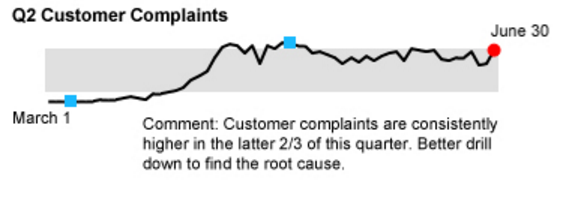 Why do some seem to recoil against KPIs? I’ve even had some refer to metrics or KPIs tracking as equivalent to “getting a root canal”. I have a few thoughts as to why.
Why do some seem to recoil against KPIs? I’ve even had some refer to metrics or KPIs tracking as equivalent to “getting a root canal”. I have a few thoughts as to why.
- Lack of Knowledge – Small business owners are not sure what metrics to track
- Once KPIs are defined, updating & tracking company KPIs is too difficult
- The process of selecting KPIs forces business owners to pick a path which makes them feel like their options are limited
- Tracking KPIs are seen as important but not urgent, so the project never gets off the ground
Have you faced these barriers when attempting to be more data-driven? Feel free to comment on any other barriers you’ve encountered.
So how do you inspire your company to love KPIs? How do you help them to see the benefits?
Here are 6 reasons to love KPIs
-
KPIs give you improved decision making and results
Ask yourself what would your rather have, more data or less when making a decision. Obviously, you need to be looking at the right data, but we’ll assume here that you’ve looking at the right performance metrics. We all go to the web looking for information when we’re making a buying decision. Having the right metrics available will help you make the right decision.
-
KPIs give you the ability to change course before it’s too late
Not everything goes according to plan. If you’ve selected the right KPIs that are leading indicators, you’ve have a great tool. You have the ability to know when it’s time to change course.
One example of a leading indicator is customer complaints. Determining the number of customer complaints can help you solve a problem with your products before it becomes a major problem.

-
KPIs improve problem solving by inviting the team to look critically the company’s data
If you are the only one in your company reviewing the KPIs, you have severely limited the impact those metrics can have on the business.
There is an incredible concept of Open Book Management whereby the entire company is shown the company’s finances. The financial performance of the company is literally an open book for everyone in the organization to see. I know this may seem a bit extreme, but it’s been shown to be extremely effective in driving results.
John Case, who coined the term “open book management” meant to focus companies on the following three objectives to generate great results.
- Share finances as well as critical metrics with all employees
- Challenge the company to move the metrics in a direction that improves the company
- All employees should share in company prosperity and success
In order to properly solve problems, the problem solvers need to be 100% tuned into the root causes of those problems. Visibility into the metrics of the business drives better problem solving.
-
Because – “What Gets Measured Gets Done” – Tom Peters
Are you frustrated with the execution of your team? Implementing a process of monthly KPI review signals to the team what is important and “what gets measure gets done”.
For example, if you are reviewing new sales each month with your staff, you are showing the company that this number is really important. This in turn engages the employees to think about ways that they can affect that number.
What about customer satisfaction? Happy customers can mean more referrals and more sales. Go one step further and tie individual compensation to these numbers and you’ve really got the employee’s attention!
-
KPIs drive increased focus
When you begin looking at a set of KPIs, it drives a focus and discipline that the business desperately needs. Greater focus drives greater results (usually).
For example, measuring customer complaints each month forces the organization to look critically and focus on the company goal of improving customer satisfaction. This activity drives conversations and stimulates new behaviors. I’ve seen many instances when leadership thought everything was fine, until it was measured.
-
KPIs create a more intelligent organization
I’ve seen this with clients who begin looking at their financial metrics on a monthly basis. At first, there are a lot of questions. The client was learning how to interpret the data, but pretty soon something interesting happens. They begin to draw conclusions. Why did we spend that much money on XYZ? Our profit margin was only 25% on that product? Why? What can we do differently?
Many times small business owners are surprised by the actual results of their business. They begin learning and growing. Poor assumptions get thrown out the window.
Hopefully these ideas will help you open a conversation and inspire you and your team to begin. Need a tool which helps you measure your KPIs that’s better than a spreadsheet? Check out the link below.
{{cta(‘b9a3ed81-299b-48e2-8fb9-4e9557ca62b9’)}}